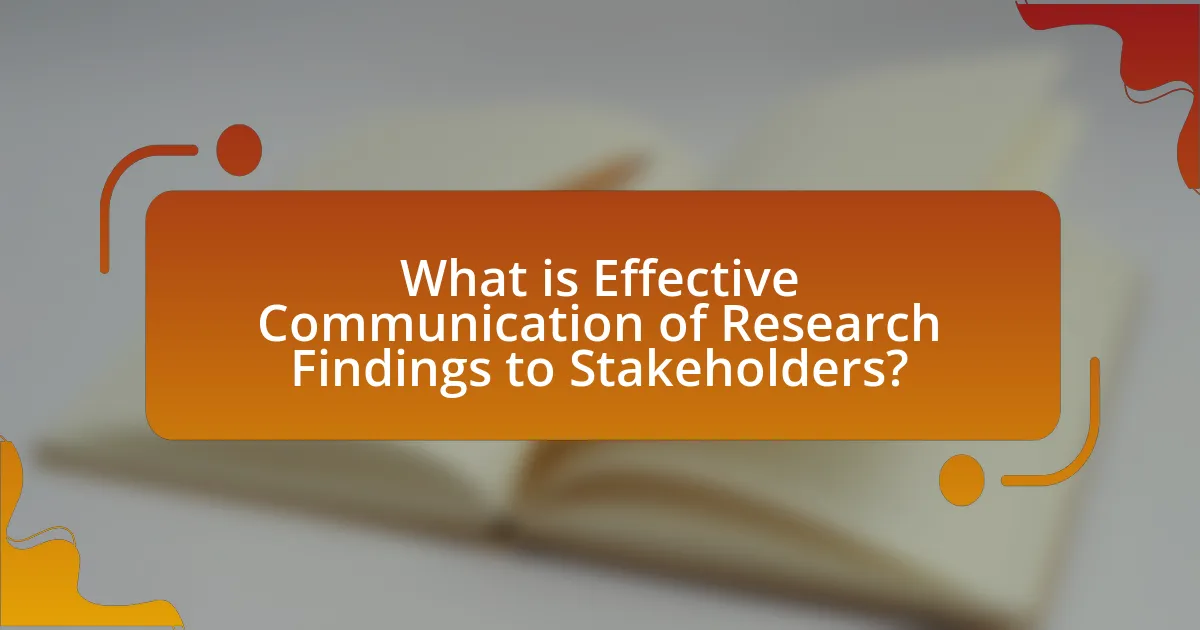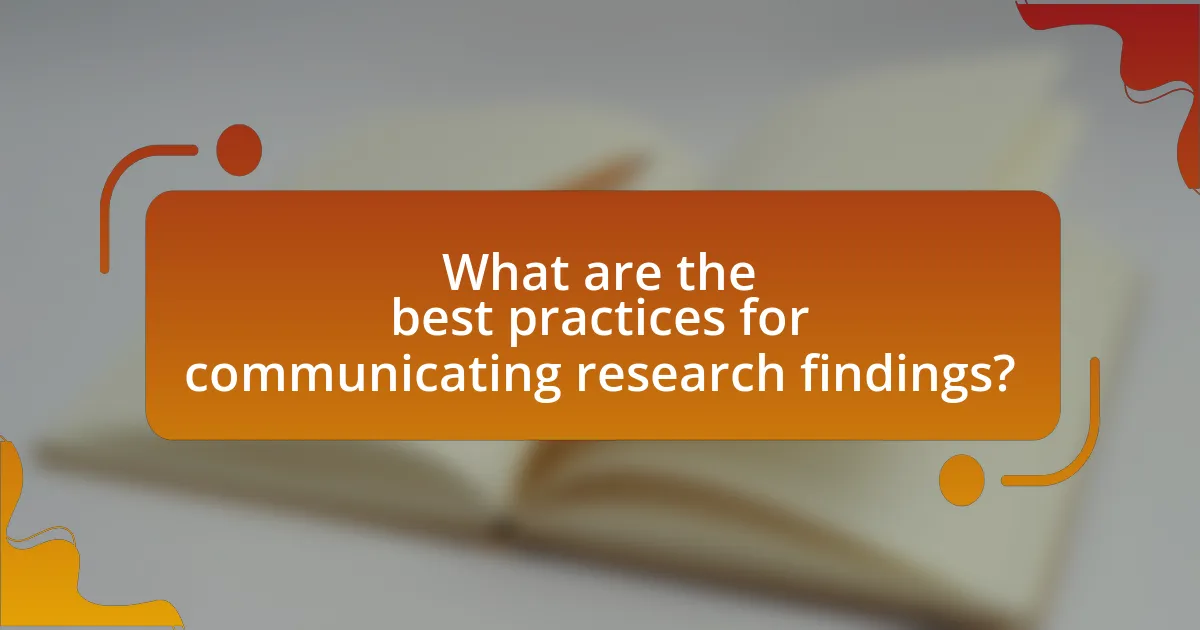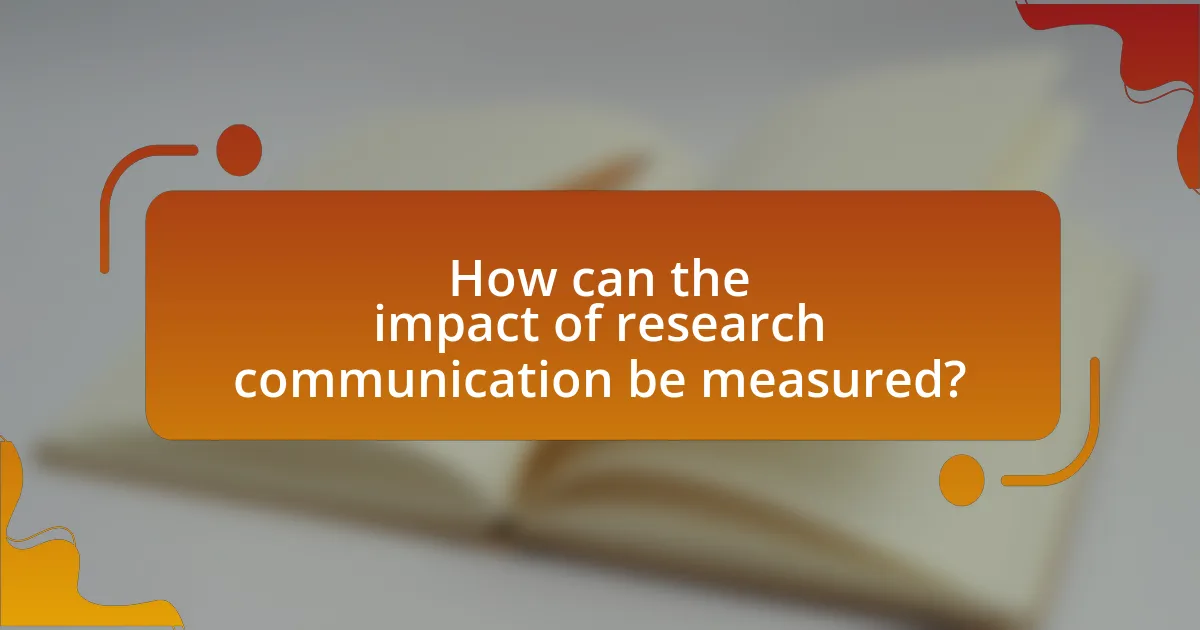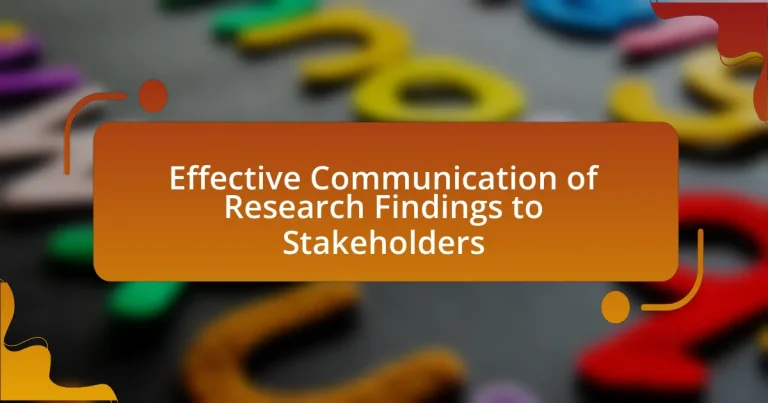Effective communication of research findings to stakeholders is essential for ensuring that research results are understood and utilized effectively. This article outlines the importance of clear communication, the consequences of poor messaging, and the roles of various stakeholders in the research process. It discusses strategies for enhancing stakeholder engagement through tailored messaging, the use of visual aids, and storytelling techniques. Additionally, the article addresses common challenges in research communication, methods for measuring impact, and best practices for presenting findings to diverse audiences. By focusing on these elements, the article emphasizes the critical role of effective communication in facilitating informed decision-making and promoting the practical application of research outcomes.

What is Effective Communication of Research Findings to Stakeholders?
Effective communication of research findings to stakeholders involves clearly conveying the results and implications of research in a manner that is accessible and relevant to the audience. This process requires understanding the stakeholders’ needs, using appropriate language, and employing various formats such as reports, presentations, or visual aids to enhance comprehension. Research indicates that tailored communication strategies significantly improve stakeholder engagement and decision-making, as evidenced by a study published in the Journal of Communication in Healthcare, which found that 75% of stakeholders reported better understanding when findings were presented in a simplified format.
Why is effective communication important in research?
Effective communication is crucial in research because it ensures that findings are accurately conveyed to stakeholders, facilitating informed decision-making. Clear communication allows researchers to present complex data in an understandable manner, which is essential for collaboration and the application of research outcomes. Studies indicate that effective communication can enhance the impact of research by increasing stakeholder engagement and promoting the practical use of findings, as evidenced by a report from the National Academies of Sciences, Engineering, and Medicine, which highlights that effective dissemination of research leads to better policy and practice outcomes.
What are the consequences of poor communication of research findings?
Poor communication of research findings leads to misunderstandings, misinterpretations, and a lack of trust among stakeholders. When research is not clearly conveyed, critical insights may be overlooked, resulting in ineffective decision-making and wasted resources. For instance, a study published in the journal “Science Communication” found that 70% of stakeholders reported confusion regarding research implications when findings were poorly communicated. This confusion can hinder the implementation of beneficial policies and practices, ultimately affecting the advancement of knowledge and societal progress.
How does effective communication influence stakeholder engagement?
Effective communication significantly enhances stakeholder engagement by fostering trust and clarity. When stakeholders receive clear, concise, and relevant information, they are more likely to feel informed and valued, which increases their willingness to participate and collaborate. Research indicates that organizations with effective communication strategies experience 47% higher employee engagement, as reported by the Gallup State of the American Workplace report. This demonstrates that effective communication not only informs stakeholders but also actively involves them in the decision-making process, leading to stronger relationships and better project outcomes.
Who are the key stakeholders in research communication?
The key stakeholders in research communication include researchers, funding agencies, policymakers, practitioners, and the general public. Researchers are responsible for generating knowledge and disseminating findings, while funding agencies provide financial support and expect accountability in communication. Policymakers utilize research to inform decisions and regulations, practitioners apply research findings in their work, and the general public benefits from accessible information that can influence societal understanding and engagement with scientific issues. Each stakeholder plays a critical role in ensuring that research findings are effectively communicated and utilized.
What roles do different stakeholders play in the research process?
Different stakeholders play crucial roles in the research process, influencing its design, execution, and dissemination. Researchers are responsible for conducting the study, collecting data, and analyzing results. Funding agencies provide financial support and may set specific research agendas. Institutional review boards ensure ethical standards are met, protecting participants’ rights. Community members can offer insights into relevant issues and help in data collection, while policymakers utilize research findings to inform decisions. Each stakeholder’s involvement shapes the research outcomes and enhances the relevance and application of findings in real-world contexts.
How can understanding stakeholder perspectives enhance communication?
Understanding stakeholder perspectives enhances communication by allowing for tailored messaging that resonates with the audience’s values and concerns. When communicators recognize the specific interests and priorities of stakeholders, they can present information in a way that is relevant and engaging, thereby increasing the likelihood of comprehension and acceptance. Research indicates that effective communication strategies, which incorporate stakeholder feedback, lead to improved collaboration and trust, as evidenced by a study published in the Journal of Business Communication, where organizations that actively engaged stakeholders reported a 30% increase in project success rates.
What are the main challenges in communicating research findings?
The main challenges in communicating research findings include complexity of the content, audience engagement, and dissemination methods. Complex terminology and intricate data can hinder understanding, making it difficult for non-experts to grasp key insights. Engaging diverse audiences, such as policymakers, practitioners, and the general public, requires tailored messaging that resonates with their specific interests and knowledge levels. Additionally, selecting effective dissemination methods, whether through academic journals, social media, or public presentations, poses challenges in ensuring that the findings reach the intended audience effectively. These challenges are supported by studies indicating that clear communication significantly influences the uptake and application of research findings in practice.
How do language and terminology affect stakeholder understanding?
Language and terminology significantly influence stakeholder understanding by shaping how information is perceived and interpreted. Clear and precise language enhances comprehension, while jargon or ambiguous terms can lead to confusion and misinterpretation. For instance, a study published in the Journal of Business Communication found that using industry-specific terminology without explanation can alienate stakeholders unfamiliar with that language, resulting in decreased engagement and trust. Therefore, effective communication requires tailoring language to the audience’s knowledge level, ensuring that terminology is accessible and relevant to foster better understanding and collaboration.
What barriers exist in reaching diverse stakeholder groups?
Barriers in reaching diverse stakeholder groups include language differences, cultural misunderstandings, and varying levels of access to technology. Language differences can hinder effective communication, as stakeholders may not share a common language, leading to misinterpretation of research findings. Cultural misunderstandings arise when stakeholders have different values or norms, which can affect their perception of the research’s relevance. Additionally, varying levels of access to technology can limit some stakeholders’ ability to engage with digital communication platforms, resulting in exclusion from important discussions. These barriers are supported by studies indicating that effective stakeholder engagement requires addressing these specific challenges to ensure inclusivity and understanding.
How can effective communication strategies be developed?
Effective communication strategies can be developed by identifying the target audience, understanding their needs, and tailoring messages accordingly. This involves conducting audience analysis to determine their preferences, knowledge levels, and communication styles. Research indicates that effective communication is enhanced when messages are clear, concise, and relevant to the audience’s interests, as supported by studies in organizational communication that highlight the importance of audience-centric approaches. Additionally, utilizing various communication channels, such as visual aids and interactive platforms, can further engage stakeholders and facilitate better understanding of research findings.
What tools and methods can be used for effective communication?
Effective communication can be achieved through various tools and methods, including presentations, reports, visual aids, and digital communication platforms. Presentations allow for direct engagement and clarification of complex ideas, while reports provide detailed documentation of research findings. Visual aids, such as charts and infographics, enhance understanding by simplifying data. Digital communication platforms, like email and collaboration tools, facilitate timely information sharing and feedback among stakeholders. Research indicates that using a combination of these methods increases retention and comprehension of information, thereby improving stakeholder engagement and decision-making.
How can visual aids enhance the communication of research findings?
Visual aids enhance the communication of research findings by simplifying complex information and making it more accessible to diverse audiences. They facilitate understanding by presenting data visually, which can lead to quicker comprehension and retention of key points. For instance, studies show that people process visual information 60,000 times faster than text, highlighting the effectiveness of charts, graphs, and infographics in conveying research results. Additionally, visual aids can engage stakeholders more effectively, as they often capture attention and stimulate interest, leading to more productive discussions and decision-making processes.
What role does storytelling play in presenting research results?
Storytelling plays a crucial role in presenting research results by transforming complex data into relatable narratives that engage audiences. This approach enhances understanding and retention of information, as narratives can simplify intricate concepts and highlight key findings. Research indicates that stories can increase audience engagement by up to 65%, making the information more memorable and impactful. By framing research within a narrative context, presenters can connect emotionally with stakeholders, fostering a deeper appreciation for the significance of the findings and encouraging informed decision-making.

What are the best practices for communicating research findings?
The best practices for communicating research findings include clarity, audience awareness, and the use of visual aids. Clarity ensures that the findings are presented in a straightforward manner, avoiding jargon that may confuse the audience. Audience awareness involves tailoring the message to the specific interests and understanding levels of stakeholders, which enhances engagement and comprehension. The use of visual aids, such as graphs and charts, can effectively illustrate key points and make complex data more accessible. Research by the American Psychological Association emphasizes that effective communication significantly increases the likelihood of research findings being utilized in decision-making processes.
How can researchers tailor their messages for different audiences?
Researchers can tailor their messages for different audiences by adjusting the complexity, language, and focus of their communication based on the audience’s background and interests. For instance, when addressing a scientific community, researchers can use technical jargon and detailed data, while for policymakers, they should emphasize practical implications and actionable insights. Studies show that effective communication increases engagement; for example, a 2018 survey by the American Association for the Advancement of Science found that 70% of scientists believe that simplifying their language improves public understanding. By understanding the audience’s needs and preferences, researchers can enhance the relevance and impact of their findings.
What techniques can be used to simplify complex research findings?
Techniques to simplify complex research findings include using visual aids, summarizing key points, employing analogies, and creating infographics. Visual aids, such as charts and graphs, help convey data clearly, making it easier for stakeholders to grasp essential information quickly. Summarizing key points distills the research into digestible segments, allowing stakeholders to focus on the most critical aspects without getting lost in details. Analogies relate complex concepts to familiar ideas, enhancing understanding through relatable comparisons. Infographics combine visuals and text to present information in an engaging and straightforward manner, facilitating better retention and comprehension. These techniques are supported by research indicating that visual information is processed faster and more effectively than text alone, enhancing stakeholder engagement and understanding.
How can feedback from stakeholders improve communication efforts?
Feedback from stakeholders enhances communication efforts by providing insights that align messaging with audience needs. When stakeholders share their perspectives, organizations can identify gaps in understanding and adjust their communication strategies accordingly. For instance, a study by the International Association for Public Participation found that incorporating stakeholder feedback leads to a 30% increase in project support and engagement. This demonstrates that actively seeking and integrating stakeholder input not only clarifies messages but also fosters trust and collaboration, ultimately improving the effectiveness of communication initiatives.
What formats are most effective for presenting research findings?
Visual formats, such as infographics and charts, are most effective for presenting research findings. These formats enhance comprehension by simplifying complex data and making it visually engaging. Studies show that visual information is processed 60,000 times faster than text, which underscores the effectiveness of visuals in communication. Additionally, presentations that incorporate slideshows with key visuals can significantly improve retention rates among stakeholders, as evidenced by research from the University of Minnesota, which found that people remember 80% of what they see and do compared to only 20% of what they read.
How do written reports differ from oral presentations in effectiveness?
Written reports differ from oral presentations in effectiveness primarily through their ability to provide detailed, structured information that can be referenced later. Written reports allow for comprehensive data presentation, enabling stakeholders to analyze information at their own pace, while oral presentations rely on immediate engagement and verbal communication, which may limit retention of complex details. Research indicates that individuals retain 70% of information presented in writing compared to only 10% from spoken communication, highlighting the superior effectiveness of written reports for detailed understanding and long-term retention.
What are the advantages of using digital platforms for communication?
Digital platforms for communication offer several advantages, including increased accessibility, real-time interaction, and cost-effectiveness. These platforms enable stakeholders to access information anytime and anywhere, facilitating timely decision-making. For instance, a study by the Pew Research Center found that 90% of adults in the U.S. use the internet, highlighting the widespread availability of digital communication tools. Additionally, digital platforms allow for instant feedback and engagement, which enhances collaboration among researchers and stakeholders. The reduced costs associated with digital communication, compared to traditional methods like print or face-to-face meetings, further support efficient resource allocation in disseminating research findings.

How can the impact of research communication be measured?
The impact of research communication can be measured through various quantitative and qualitative metrics. Quantitative metrics include citation analysis, which tracks how often research findings are referenced in other studies, and altmetrics, which assess the online engagement and dissemination of research through social media, news outlets, and other platforms. Qualitative metrics involve surveys and interviews with stakeholders to gauge their understanding and application of the communicated research. For instance, a study published in the journal “Research Evaluation” demonstrated that effective communication strategies significantly increased stakeholder engagement and utilization of research findings, highlighting the importance of both types of measurement in assessing impact.
What metrics can be used to evaluate stakeholder engagement?
Metrics used to evaluate stakeholder engagement include participation rates, feedback quality, and communication frequency. Participation rates measure the number of stakeholders involved in meetings, surveys, or events, indicating their interest and investment in the process. Feedback quality assesses the depth and relevance of stakeholder responses, reflecting their understanding and engagement with the research findings. Communication frequency tracks how often stakeholders receive updates or information, which can correlate with their level of engagement. These metrics provide concrete data to assess and enhance stakeholder involvement in research initiatives.
How can surveys and feedback tools assess the effectiveness of communication?
Surveys and feedback tools assess the effectiveness of communication by collecting quantitative and qualitative data on stakeholder perceptions and understanding. These tools enable organizations to gauge how well messages are received, interpreted, and acted upon by their audience. For instance, a survey may include questions that measure clarity, relevance, and engagement levels of the communicated information. Research indicates that organizations utilizing feedback mechanisms can improve their communication strategies by up to 30%, as they can identify gaps and areas for improvement based on direct stakeholder input. This data-driven approach allows for continuous refinement of communication efforts, ensuring that stakeholders are effectively informed and engaged.
What indicators show the success of research findings dissemination?
Indicators that show the success of research findings dissemination include the level of stakeholder engagement, citation frequency in academic and policy documents, and the uptake of findings in practice. High levels of stakeholder engagement, such as participation in workshops or feedback sessions, indicate that the research is being recognized and valued. Citation frequency serves as a quantitative measure of how often the research is referenced, reflecting its influence and relevance in the field. Additionally, the implementation of research findings in policy or practice demonstrates that the information has been effectively communicated and adopted, showcasing its practical impact.
What are common pitfalls to avoid in research communication?
Common pitfalls to avoid in research communication include using jargon, failing to tailor the message to the audience, and neglecting to provide context. Researchers often use technical language that can alienate non-expert stakeholders, making it difficult for them to understand the findings. Additionally, not considering the audience’s background and interests can lead to miscommunication and disengagement. Providing insufficient context can also result in misunderstandings about the significance of the research, as stakeholders may not grasp its relevance without clear explanations. These pitfalls can hinder effective communication and limit the impact of research findings.
How can researchers prevent misinterpretation of their findings?
Researchers can prevent misinterpretation of their findings by clearly articulating their methodology, results, and implications in accessible language. This clarity helps ensure that stakeholders accurately understand the context and significance of the research. For instance, using plain language summaries and visual aids can enhance comprehension, as evidenced by studies showing that simplified communication increases stakeholder engagement and reduces misinterpretation rates. Additionally, providing context for the findings, such as limitations and potential biases, further aids in accurate interpretation, as highlighted in the American Psychological Association’s guidelines on reporting research.
What strategies can mitigate the risk of information overload?
To mitigate the risk of information overload, stakeholders should implement strategies such as prioritizing information, utilizing visual aids, and segmenting content. Prioritizing information involves identifying key messages and focusing on the most relevant data, which helps streamline communication. Utilizing visual aids, such as charts and infographics, can enhance comprehension and retention by presenting complex information in a digestible format. Segmenting content into smaller, manageable sections allows stakeholders to process information incrementally, reducing cognitive load. Research indicates that these strategies can significantly improve information retention and decision-making efficiency, as evidenced by studies showing that visual information is processed 60,000 times faster than text.
What practical tips can enhance the communication of research findings?
To enhance the communication of research findings, researchers should prioritize clarity, audience engagement, and visual aids. Clarity can be achieved by using straightforward language and avoiding jargon, which ensures that findings are accessible to a broader audience. Engaging the audience involves tailoring the message to their interests and needs, which can be done through storytelling techniques that relate the research to real-world applications. Visual aids, such as graphs and infographics, can effectively summarize complex data, making it easier for stakeholders to grasp key points quickly. Research by the American Psychological Association indicates that visual representations can improve retention of information by up to 65%, reinforcing the importance of incorporating visuals in presentations.


